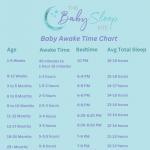
Don’t freak out at that title. Yes, I know it seems odd – this is The Baby Sleep Site®, after all! Shouldn’t we be talking about how to put an awake baby to sleep, and not the other way around? Well, stick with me. While we do specialize in helping sleepless babies find their sleep, we also offer tips on how to keep a baby awake – or how to wake a sleeping baby – and when it makes sense to wake your baby. And one of the occasions, when you may find you need to keep your baby awake, is during breastfeeding.
Why Keep Baby Awake During Breastfeeding?
You may be wondering why some parents even want to keep their babies awake during breastfeeding; after all, breastfeeding is naturally sleep-inducing and gives parents a fast and effective way to get baby to sleep.
However, there are times when you may want to keep your baby awake during and after breastfeeding. Those times include….
….when your baby is falling asleep early in a feeding and not taking in full breastfeeds. This, in turn, can mean your baby feeds almost constantly day and night, and never gets any longer stretches of sleep.
….when you want to wean your child away from her breastfeeding sleep associations, and therefore need to keep her awake throughout and after the feeding.
We checked in with Miriam, a friend and lactation consultant, and asked her to share her top tips for how to keep a baby awake during breastfeeding.
How To Keep Newborn Awake During Breastfeeding
Remember the following pointers:
- Newborns naturally get drowsy while nursing, and we really don’t worry too much about your newborn falling asleep while nursing unless there are concerns with weight gain or jaundice.
- Newborns with jaundice tend to be very sleepy and it’s important to wake them and attempt to nurse every 2 hours during the day. The more they drink, the more they poop; the more they poop, the less jaundice they will have, and the more alert they will become.
- If weight gain is an issue for your newborn then be sure to use breast massage and compressions to maximize the amount of breastmilk your child takes in at each feeding. Babies are very smart and they won’t waste energy at the breast if they aren’t getting milk, so don’t hesitate to use breast compressions to encourage more milk flow. You can also switch breasts every 5-7 minutes to encourage faster flow and more suckling.
Now, if you are worried that your baby is eating too often it’s important to understand that nursing every 2-3 hours is normal throughout the first year. It’s not necessarily “normal” for all babies to nurse every 3-4 hours; some will need to eat more frequently. The babies who can get by with feeding every 3-4 hours are usually older babies on solid foods who can get 5+ ounces of breastmilk at each breast feeding.
If your baby is nursing hourly, then do speak with your doctor or a local lactation consultant. This can still be normal during a growth spurt, but it can also indicate problems with breastfeeding, like latch or supply problems. Always check in with a healthcare provider if your baby seems drowsy all the time and isn’t having lots of wet and dirty diapers.
How To Keep Baby Awake During Breastfeeding
One great way to keep your baby awake during breastfeeding is to work towards a daily feeding and nap schedule. Here are some basic steps you can use to move towards a schedule:
- Start the day in the same 30 minute window each day (called a “fixed point”).
- Nurse your baby shortly after “starting the day”.
- For babies on a 90 minute cycle of eat-play-sleep, it’s fine to feed after the nap, but once the cycles are 120 minutes or longer you will likely need to move the feeding about 20 minutes before the nap so your baby doesn’t wake too early due to hunger. Offer a feeding even if you don’t think your baby is hungry.
- It’s always okay to gently offer an extra feeding to help your baby get on a better schedule. You might do this prior to a nap or prior to going out for the day.
If you feel that your baby still isn’t taking a full feeding, even after you’ve worked towards a more predictable feeding schedule:
- Keep in mind that sometimes babies just need a drink and that’s okay! 🙂
- To encourage a bigger feeding, especially if you know you won’t have the opportunity to feed again (car trip, going out, bedtime feeding, etc), then be sure to use breast massage before the feeding and breast compressions after the feeding.
- Don’t use a wet washcloth or anything too harsh to get your baby to nurse. Instead try running your finger gently along his cheek or foot.
- Skin to skin contact is a great way to get your baby to wake-up and stay awake during a feeding. Even very sleepy babies will be motivated to nurse more often and for longer periods if they are skin to skin on mom’s chest.
How To Keep Baby Awake During Breastfeeding In Order To Solve A Sleep Association
Once you have established a decent daytime nap and feeding schedule, and you know your baby is taking in full feedings, you may find you need to keep your baby awake during breastfeeding not necessarily for nourishment, but in order to teach healthy sleep habits. Nursing to sleep is a really common sleep association, and it’s key to help your child learn how to breastfeed at bedtime or at nap time without falling asleep. But that’s easier said than done!
Generally speaking, it’s a good idea in this situation to move the feeding to an earlier point in the bedtime or nap time routine. If you usually breastfeed right before laying your child down for sleep, try breastfeeding first, and then going through the other steps in your routine. This not only helps keep your child awake, it also separates feeding and sleep enough that your child will stop associating them in his mind.
Baby Falling Asleep While Breastfeeding and Nursing? We Can Help!
If you’re struggling with your baby’s sleep and feeding habits, don’t worry – our team of experts can help! Connect with one of our expert consultants today; she’ll craft a Personalized Sleep Plan™ just for your baby, walk you through every step of sleep training, and provide detailed answers to your most pressing sleep training questions.
Purchase a sleep consulting package today, and connect with your expert sleep consultant!
Once you make your choice and purchase, you will immediately receive an e-mail with your Helpdesk login information. You’ll be able to log in and get started immediately!
 Or, join our VIP Members Area packed with exclusive content and resources: e-Books, assessments, detailed case studies, expert advice, peer support, and more. It actually costs less to join than buying products separately! And don’t forget that as a member, you’ll also enjoy a weekly chat with an expert sleep consultant, which is perfect if you have truly tough, pressing sleep coaching questions that require expert help.
Or, join our VIP Members Area packed with exclusive content and resources: e-Books, assessments, detailed case studies, expert advice, peer support, and more. It actually costs less to join than buying products separately! And don’t forget that as a member, you’ll also enjoy a weekly chat with an expert sleep consultant, which is perfect if you have truly tough, pressing sleep coaching questions that require expert help.








